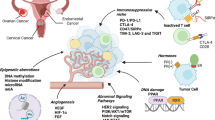Opinion statement
The implementation of new drug treatments has improved the prognosis for advanced cancers of the cervix, uterus, and ovary. Platinum analogs are the most effective drugs in the treatment of ovarian cancer. Other drugs, such as oxaliplatin, have been proposed as a rational treatment of platinum refractory ovarian cancer. Epothilones are also being studied in clinical trials, as are histone deacetylase inhibitors. Several promising agents may soon receive Food and Drug Administration approval.
Similar content being viewed by others
References and Recommended Reading
Fink D, N∄bel S, Aebi S, et al.: The role of mismatch repair in acquired platinum drug resistance. Cancer Res 1996, 56:4881–4886.
Vaisman A, Varechenco M, Umar A, et al.: The role of hMLH1, hMSH3 and hMSH6 defects in cisplatin and oxalipatin resistance: correlation with replicative bypass of platinum-DNA adducts. Cancer Res 1998, 58:3579–3585.
Sessa C, ten Bokkel Huinink WW, du Bois A:Oxaliplatin in ovarian cancer. Ann Oncol 1999, 10(suppl):S55-S57.
Piccart MJ, Green JA, Lacave AJ, et al.: Oxaliplatin or paclitaxel in patients with platinum pretreated advanced ovarian cancer: a randomized phase II study of the European Organization for Research and Treatment of Cancer Gynecology Group. J Clin Oncol 2000, 18:1193–1202.
Holford J, Sharp SY, Murrer BA, et al.: In vitro circumvention of cisplatin resistance by the novel sterically hindered platinum complex AMD473. Br J Cancer 1998, 77:366–373.
Raynaud FI, Boxall FE, Goddard PM, et al.: Cis Amminedichloro(2methylpyridine) Platinum (II) (AMD473), a novel sterically hindered platinum complex: in vivo activity, toxicology and pharmacokinetics in mice. Clin Cancer Res 1997, 3:2063–2074.
Trigo JM, Beale P, Judson IR, et al.: Phase I and pharmacokinetic study of cis diamminedichloro(2-methylpyridine) platinum II (ZD0473), a novel sterically hindered platinum complex in patients with advanced solid malignancies. ASCO 1999, abstract 648.
Manzotti C, Pratesi G, Menta E, et al.: BBR 3464— a novel triplatinum complex exhibiting a preclinical profile of antitumor efficacy different from cisplatin. Clin Cancer Res 2000, 6:2626–2634.
Sharp SY, Kelland LR: BBR-3464. Current Opinion in Oncologic, Endocrine and Metabolic Investigational Drugs 2000, 2:353–360.
Pratesi G, Perego P, Polizzi D, et al.: A novel charged trinuclear platinum complex effective against cisplatin resistant tumors: hypersensitivity of p53 mutant human tumors xenografts. Br J Cancer 1999, 80:1912–1919.
Kowalski RJ, Giannakakou P, Hamel E: Activities of the microtubulin stabilizing agents epothilones A and B with purified tubulin and in cells resistant to paclitaxel (taxol). J Biol Chem 1997, 272:2534–2541.
Chou TC, Zhang XG, Balog A, et al.: Desoxyepothilone B: an efficacious microtubule targeted antitumor agent with a promising in vivo profile relative to epothilone B. Proc Natl Acad Sci U S A 1998, 95:9642–9647.
Calvert PM, O’Neill V, Azzabi A, et al.: A phase I clinical and pharmacokinetic study of EPO906 (epothilone B) in patients with advanced solid tumors. 11th Annual NCI-EORTC-AACR Symposium, 2000. Abstract 257.
Warrell R, He LZ, Richon V, et al.: Therapeutic targeting of transcription in acute promyelocytic leukemia by use of an inhibitor of histone deacetylase. J Natl Cancer Inst 1998, 90:1621–1625.
Cameron E, Bachman KE, Myohanen S, et al.: Synergy of demethylation and histone deacetylase inhibition in the re-expression of genes silenced in cancer. Nat Genet 1999, 21:103–107.
Ciechanover A: The ubiquitin-proteasome pathway: on protein death and cell life. Embo J 1998, 17:7151–7160.
Hershko A, Ciechanover A: The ubiquitin system. Annu Rev Biochem 1998, 67:425–479.
Adams J, Palombella VJ, Elliott PJ: Proteasome inhibition: a new strategy in cancer treatment. Invest New Drugs 2000, 18:109–121.
Teicher BA, Ara G, Herbst R, et al.: The proteasome inhibitor PS-341 in cancer therapy. Clin Cancer Res 1999, 5:2638–2645.
Glas R, Bogyo M, McMaster JS, et al.: A proteolytic system that compensates for loss of proteasome function. Nature 1998, 392:618–622.
Drexler HC: Activation of the cell death program by inhibition of proteasome function. Proc Natl Acad Sci U S A 1997, 94:855–860.
Uehara Y, Hori M, Takeuchi T, Umezawa H: Screening of agents which convert“transformed” morphology of RSV infected kidney cells“normal” cells: identification of active agent as herbimycin and its inhibition of src kinase. Jpn J Cancer Res 1985, 76:672–675.
Stebbins CE, Russo AA, Schnieder C, et al.: Crystal structure of an Hsp90-geldaamycin complex; targeting of a protein chaperone by an antitumor agent. Cell 1997, 89:239–250.
Schnur RC, Corman ML, Gallaschun RJ, et al.: Inhibition of the oncogen product p185erB-2 in vitro and in vivo by geldanamycin and derivatives. J Med Chem 1995, 38:3806–3812.
Schulte TW, Blagosklonny MV, Ingui C, Neckers L:Disruption of the Raf-1 Hsp90 molecular complex results in destabilization of Raf1 and loss of Raf-1 Ras association. J Biol Chem 1995, 270:24585–24588.
Srethpakdi M, Liu F, Tavorath R, Rosen N: Inhibition of Hsp90 function causes Rb dependent G1 arrest. Cancer Res 2000, 60:3940–3946.
Münster PN, Srethapakdi M, Moasser MM, Rosen N: Inhibition of Hsp90 function by ansamycins causes the morphological and functional differentiation of breast cancer cells. Cancer Res, In press.
Al-Obeidi FA, Lam KS: Development of inhibitors for protein kinases. Oncogene 2000, 19:5690–5701.
Stebbing J, Copson E, O’Reilly S: Herceptin (transuzamab) in advanced breast cancer. Cancer Treat Rev 2000, 26:287–290.
Mendelsohn J: Epidermal growth factor receptor inhibition by a monoclonal antibody as anticancer therapy. Clin Cancer Res 1997, 12:2703–2707.
Baselga J, Pfister D, Cooper MR, et al.: Phase I studies of anti-epidermal growth factor receptor chimeric antibody C225 alone and in combination with cisplatin. J Clin Oncol 2000, 18:904–914.
Sirotnak FM, Zakowski MF, Miller VA, et al.: Efficacy of cytotoxic agents against human tumor xenografts is markedly enhanced by coadministration of ZD1839 (Iressa), an inhibitor of EGFR tyrosine kinase. Clin Cancer Res 2000, 67:4885–4892.
Baselga J, Averbusch SD: ZD1839 (‘Iressa’) as an anticancer agent. Drugs 2000, 60(suppl):33–40.
Author information
Authors and Affiliations
Rights and permissions
About this article
Cite this article
Daud, A., Munster, P. & Spriggs, D.R. New drugs in gynecologic cancer. Curr. Treat. Options in Oncol. 2, 119–128 (2001). https://doi.org/10.1007/s11864-001-0054-0
Issue Date:
DOI: https://doi.org/10.1007/s11864-001-0054-0




